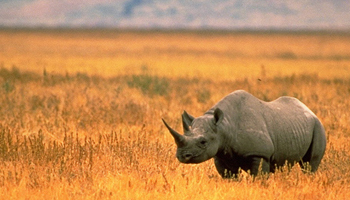Speaking of mass extinction...
This one has been a while coming. Toward the end of last year, several science news outlets picked up a striking article in the journal Biological Conservation. In short, it suggested that current guidelines for setting minimum population sizes for protected species, like the black rhinoceros, are at least an order of magnitude (10x) too low to adequately protect them from extinction in this century. The current guidelines adhere to a "50/500" rule, in which a minimum of 50 adults are required to avoid the negative effects of inbreeding, and a minimum of 500 to be able to adapt to long-term environmental changes or rebound from a catastrophic event.
Ten times too low. Put a big, flashing exclamation point at the end of that one. Horrifying corollaries are immediately evident: many species are already too far gone to be preserved in the long term even if we dropped everything to triage them now, and species we think we've done a bang-up job of protecting to date may just need one calamity to drop them below that point of no return. In light of the political difficulties - an understatement by any measure - of maintaining even today's meager/modest conservation measures, a tenfold increase will never happen. These species, humble to majestic, mountain gorilla (~400) to desert pupfish (42!), are going away sooner than we'd like.
It is not an encouraging picture.

Black rhinoceros. Photo credit John and Karen Hollingsworth, USFWS, from Wikimedia Commons.
This is not a political blog, so we'll leave the issue behind and look at what these numbers mean. Why do we need X number of animals to avoid catastrophe? The first barrier, inbreeding, is intuitively obvious: offspring are produced by close genetic relatives. Put another way, the two copies that an individual carries of each her genes have a high probability of being identical by descent, or having come from the same ancestor (grandma) independently through each parent. Gross, yeah. But why is this necessarily a bad thing? Every human has two identical copies - alleles - of at least some genes, and we're not all running around with horrible genetic abnormalities. Things go south (no pun intended; I am from Texas after all) when you deal with genes that have a healthy version and a defective one.
At many gene locations in your DNA, you have one healthy allele and one defective one. In most cases, the normal copy steps up and does a stalwart job compensating for the freeloader. You'll never notice that one copy is bad, and so we call that copy a recessive, or hidden allele. That's the good news. The bad news is that they're ticking time bombs on a generational timescale. When you reproduce, one of those alleles is "drawn" at random to end up in your sperm or eggs. If you pass on the healthy version, great, your child will be A-OK for that gene. If not, you'd better hope that your mate contributes a healthy copy to pull the weight for your freeloader. If two recessive alleles end up in the offspring, she won't be able to make that gene's normal protein product. The effects may be mild, and even desirable to some: blond hair or blue eyes. Or instead, they may cause a serious genetic malady like cystic fibrosis or sickle cell anemia. If you have one healthy and one hidden, defective allele for a disease-associated gene, you are a carrier. Everyone on the planet is a carrier for an unknown, but probably not inconsiderable, number of genetic disorders. This is the basis behind genetic testing, which is becoming cheaper and more widely available every year.
The rest is easy to follow. If you're a cheetah and there are only a handful of your species left (the cheetah-reality is not that dire), the odds that you are closely related to any other cheetah you see are much higher than they are for a species with larger population sizes, like industrialized humans. If you mate with that cheetah, your odds of having the same set of alleles from a common ancestor are high, and an increasing proportion of offspring will either have two healthy or two defective copies of a gene - allele fixation. You can see how the situation degrades quickly once disease traits become universal in a population. Lost genetic diversity takes a long, long time to be recovered.
The second, higher requirement for a minimum viable population size (the 500 of the 50/500 rule) is trickier to understand. It builds on the concept of inbreeding, but the higher number of organisms keeps a larger gene pool - the total genetic variation in a population - available into the future. High genetic variation gives a population options, so to speak, in the face of environmental change. There may be warmer-adapted cheetah alleles that would do better under increased temperatures, or slightly faster cheetahs that can better keep up with Thomson's gazelles, which are under similar pressures. Perhaps most importantly, it provides options for [pathogenic] disease resistance.
Viruses, bacteria, and other parasites are engaged in a constant arms race with their hosts at a molecular level. Genetic variability goes a long way to ensure that at least some cheetahs will survive a potent disease, while if they are genetically homogeneous, a single bacterial strain that has "figured them out" can wipe out the whole population in one fell swoop. As a great recent example, humans of European descent have a much higher incidence of a genetic mutation called CCR5-delta32 that provides resistance to HIV. This mutation also appears to confer resistance to the great historical European plagues. That is, some Europeans had this mutant allele and became resistant to plague, while other didn't and were selected against. If Europe's population had been much smaller, this mutation may have never arisen and the entire continent could have been taken out in one of those dread epidemics.
A grim picture, to be sure. The next steps are political, but having been introduced to the science, hopefully you are in a better position to weigh the costs and benefits of conservation measures for yourself.
Here's to an educated democracy.


Neil, I have 3 points
ReplyDelete1 - could you argue that the heterogeneity borne of having many of a given species might lead to mutations that are destructive to the species as a whole? Like, for instance, a Hitler gene? Does the ability to compute a floor number indicate that it's possible to compute an optimal population number for genetic survivability? Could that number be computed for humans? If a person bothered to compute that number for humans, would that mean that that person had the Hitler gene? Or only if they wanted to enforce that number? Could hubris be genetic? are there actual instances of genetic variations that were damaging to the survivability of the species as a whole that aren't just classical greek character flaws? is curiosity a greek character flaw or genetic? if genetic, does it contribute to or detract from the survivability of the species that bear it?
2 - does this mean you're part of the secret bug lobby? if it's diversity you're after, I bet you'd see a lot of cool new species fill in the voids left in the biosphere by the destruction of all insects. Some kind of cute new fish, maybe.
3 - thank you for telling me that interesting fact about how I, as a white person, don't have to worry about getting AIDS, i feel way more educated now, and will endeavor to educate my peers as well.
1. Yes and no. No in the short term - deleterious alleles are expunged faster with larger population sizes. Yes in the long term - many of the traits that have served our species so well for millennia currently see us hurtling toward (and well past) the carrying capacity of the planet. And then some. Hubris could be genetic, as long as people like Odysseus sire offspring BEFORE getting wrecked by Poseidon.
ReplyDelete2. Most definitely NOT. But I am always in favor of screwed up new fish (see: batfish/frogfish).
3. Play safe and properly exchange your needles. Only a few whites have even one copy, and even then it's just partial resistance.
Thanks for stopping by, good sir. :)
Interesting blog. I worked for the USFWS in the ESA division for a short while and actually took the analyzing the ESA as one of my law school papers.
ReplyDeletePolitically, we tend to focus on charismatic meglafauna, which isn't necessarily a bad thing. Hard to get people excited about an endangered tick, but pretty easy to get people excited about a bear. As the bear's range/habitat may be the same as the endangered tick, protecting the bear fiercely protects the tick. My work with USFWS was largely spent protecting fairy shrimp--telling a developer he's paying a million dollar mitigation fee for a sea monkey, well, let's just say political will starts to turn on you. But the biggest flaw with the implementation of the ESA is the EPA's adamant refusal, despite the legal obligation, to designate critical habitat. In fact, every time they're forced to do so, they publish a rant in the notice about how stupid it is. Their argument is that their species analysis takes habitat into account; the counter argument (and the winning argument, i feel), protects land despite having enough alternative land for the species itself to survive. Because we DO underestimate our long-term impacts, only by protecting critical habitat as fiercely as the species itself will they have any hope of surviving. Otherwise, they go the way of the Florida Panther.
Several years ago, the Florida Panther's numbers had been so depleted that, as you'd mentioned, incest had caused one fatal abnormality: sterile offspring. The population dipped below the 50 adults you'd mentioned, and many feared many of those were sterile. So, in response, they introduced a cat from your native home--the Texas Cougar. As a result, they guaranteed the full extinction of the Florida Panther forever--not that they were left with much choice. Hybrid species, under the ESA, are actually protected as if the species were a full fledged member of either one of its parents' species.
Anyway, a topic near and dear to my heart! Thanks for the blog!
There are some natural remedies that can be used in the prevention and eliminate diabetes totally. However, the single most important aspect of a diabetes control plan is adopting a wholesome lifestyle Inner Peace, Nutritious and Healthy Diet, and Regular Physical Exercise. A state of inner peace and self-contentment is essential to enjoying a good physical health and overall well-being. The inner peace and self contentment is a just a state of mind.People with diabetes diseases often use complementary and alternative medicine. I diagnosed diabetes in 2010. Was at work feeling unusually tired and sleepy. I borrowed a cyclometer from a co-worker and tested at 760. Went immediately to my doctor and he gave me prescriptions like: Insulin ,Sulfonamides,Thiazolidinediones but Could not get the cure rather to reduce the pain but bring back the pain again. i found a woman testimony name Comfort online how Dr Akhigbe cure her HIV and I also contacted the doctor and after I took his medication as instructed, I am now completely free from diabetes by doctor Akhigbe herbal medicine.So diabetes patients reading this testimony to contact his email drrealakhigbe@gmail.com or his Number +2348142454860 He also use his herbal herbs to diseases like:SPIDER BITE, SCHIZOPHRENIA, LUPUS,EXTERNAL INFECTION, COMMON COLD, JOINT PAIN, EPILEPSY,STROKE,TUBERCULOSIS ,STOMACH DISEASE. ECZEMA, PROGENITOR, EATING DISORDER, LOWER RESPIRATORY INFECTION, DIABETICS,HERPES,HIV/AIDS, ;ALS, CANCER , MENINGITIS,HEPATITIS A AND B,ASTHMA, HEART DISEASE, CHRONIC DISEASE. NAUSEA VOMITING OR DIARRHEA,KIDNEY DISEASE. HEARING LOSSDr Akhigbe is a good man and he heal anybody that comes to him. here is email drrealakhigbe@gmail.com and his Number +2349010754824
ReplyDelete